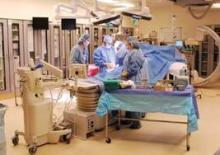To ensure appropriate implementation and use of transcatheter aortic valve replacement in medical centers across the United States, four leading cardiovascular organizations have pooled their knowledge and issued a consensus document.
The document comes 2 months after the Food and Drug Administration approved the first minimally invasive transcatheter aortic valve replacement (TAVR) system (J. Am. Coll. Cardiol. 2012 Jan. 31; doi:10.1016/j.jacc.2012.001).
The document reviews in detail several aspects of the procedure, including the current state of evidence, patient selection, management of complications and steps to integrating TAVR into practice.
"Our goal in crafting this expert consensus document is to provide a clear road map for the use of TAVR as it reaches patients across the United States," Dr. Michael J. Mack, medical director of cardiovascular surgery at Baylor Health Care System, Heart Hospital Baylor Plano (Tex.), president of the Society of Thoracic Surgeons, and vice chair of the writing committee, said in a statement.
The report also recommends establishment of a national registry by cardiovascular organizations and not the industry, to create standard definitions and data specifications and to avoid the potential for conflict of interest.
In the expert consensus, the organizations also stress that the procedure’s rollout is a "key issue" in the United States. "The rollout is influenced by the societal beliefs in a free market, convenient and timely access to medical care, patient and physician expectations, as well as return on investment by companies and institutions alike," according to the report.
What complicates the rollout, they added, is the proliferation of advanced cardiovascular facilities.
Take, for instance, Los Angeles County, which has 33 cardiovascular surgical and primary ST-elevation myocardial infarction centers. If all these centers were to offer TAVR, the result would be "the dilution of concentrated experience," the report stated.
So, establishment of specialized centers of excellence should be a top priority, the report advised.
"As this technology is introduced into practice, detailed and agreed upon protocols are needed to ensure we achieve optimal clinical results," Dr. David R. Holmes, professor of medicine at Mayo Clinic in Rochester, Minn., president of the American College of Cardiology, and chair of the writing committee, said in a statement.
Nearly 45,000 patients have received TAVR around the world, but the experience with the procedure in the United States lags far behind that in Europe. Five different valves are currently in widespread use across Europe. In the United States, the first valve, Edwards Sapien, was approved in 2011 for use in inoperable patients with severe aortic stenosis. Other use of the Sapien valve is limited to clinical trials. Medtronic’s CoreValve is also in being studied in large U.S. trials. The report lists several next-generation devices under investigation.
"TAVR innovation is a major advance in treating aortic stenosis and sick, elderly patients should have access to this new treatment so they can resume normal, active lives," Dr. Mack said in a statement. "These guidelines are a coordinated effort from the cardiovascular community to help ensure the appropriate use of TAVR therapy for optimum patient safety."
The American College of Cardiology Foundation, the American Association for Thoracic Surgery, the Society for Cardiovascular Angiography and Interventions, and the Society of Thoracic Surgeons were the main authors of the consensus document. Eight other medical and consumer groups were involved in the writing and endorsement of the document.
Dr. Mack and Dr. Holmes reported no relevant disclosures.


